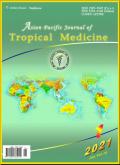Applications of nanomaterials in mosquito vector control: A review
IF 1.6
4区 医学
Q3 PUBLIC, ENVIRONMENTAL & OCCUPATIONAL HEALTH
引用次数: 0
Abstract
The periodic outbreak of mosquito-borne diseases like dengue fever, zika fever, and yellow fever all over the world highlights the need for effective mosquito control methods targeting the biological system. Due to the lack of therapeutic measures, preventive treatments or vaccines against pathogens, insecticide resistance eventually lead the research focus towards novel technological applications in mosquito management. Nanomaterials with ovicidal, larvicidal, adulticidal, and repellent properties for controlling mosquito vectors are under research. A literature search was carried out for advancements in nanomaterials, insecticides, and mosquito control in PubMed/MEDLINE, Scopus, Google Scholar, ScienceDirect, and Web of Science. This paper aims to provide insights into various nanomaterials relevant to mosquito-borne diseases, in vivo and in vitro toxicity evaluation against mosquito species, mode of action, effect on non-target organisms, and ecological risks. Organic and inorganic materials that provide controlled release, target delivery, less dosage, prolonged efficacy, a reduction in the use of organic solvents and emulsifiers, and minimum pollution to the environment have already been explored. Indeed, further research on the ecological risk and economic feasibility of nanomaterials in mosquitocidal applications should be done prior to commercialization.纳米材料在蚊媒控制中的应用:综述
登革热、寨卡热和黄热病等蚊媒疾病在世界各地的周期性爆发,凸显了针对生物系统的有效蚊虫控制方法的必要性。由于缺乏针对病原体的治疗措施、预防治疗或疫苗,杀虫剂的抗药性最终导致研究重点转向蚊虫管理方面的新型技术应用。目前正在研究具有杀卵、杀幼虫剂、杀成虫和驱避特性的纳米材料,以控制蚊虫媒介。我们在 PubMed/MEDLINE、Scopus、Google Scholar、ScienceDirect 和 Web of Science 中对纳米材料、杀虫剂和蚊虫控制方面的进展进行了文献检索。本文旨在深入探讨与蚊媒疾病相关的各种纳米材料、对蚊子物种的体内和体外毒性评估、作用模式、对非目标生物的影响以及生态风险。人们已经探索了能够控释、靶向给药、减少用量、延长药效、减少有机溶剂和乳化剂的使用以及将环境污染降到最低的有机和无机材料。事实上,在商业化之前,应进一步研究纳米材料在灭蚊应用中的生态风险和经济可行性。
本文章由计算机程序翻译,如有差异,请以英文原文为准。
求助全文
约1分钟内获得全文
求助全文
来源期刊

Asian Pacific journal of tropical medicine
PUBLIC, ENVIRONMENTAL & OCCUPATIONAL HEALTH-TROPICAL MEDICINE
CiteScore
4.00
自引率
9.70%
发文量
1936
审稿时长
3-8 weeks
期刊介绍:
Asian Pacific Journal of Tropical Medicine (ISSN 1995-7645 CODEN: APJTB6), a publication of Editorial office of Hainan Medical University,is a peer-reviewed print + online Monthly journal. The journal''s full text is available online at http://www.apjtm.org/. The journal allows free access (Open Access) to its contents and permits authors to self-archive final accepted version of the articles on any OAI-compliant institutional / subject-based repository.
APJTM aims to provide an academic communicating platform for international physicians, medical scientists, allied health scientists and public health workers, especially those of the Asia-Pacific region and worldwide on tropical medicine, infectious diseases and public health, and to meet the growing challenges of understanding, preventing and controlling the dramatic global emergence and re-emergence of infectious diseases in the Asia-Pacific.
The journal is proud to have an international and diverse editorial board that will assist and facilitate the publication of articles that reflect a global view on tropical medicine, infectious diseases and public health, as well as emphasizing our focus on supporting the needs of public health practitioners. The APJTM will allow us to seek opportunities to work with others who share our aim, and to enhance our work through partnership, and to uphold the standards of our profession and contribute to its advancement.
 求助内容:
求助内容: 应助结果提醒方式:
应助结果提醒方式:


